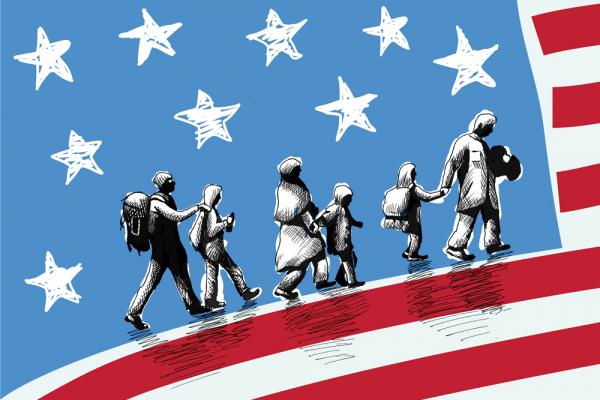IN 2016, PEOPLE of faith in the city of Billings, Mont., gathered to call for their community to get more involved in resettling refugees. With growing violence, persecution, and strife around the world and a record number of people forced to flee their homes, this community had the heart to help.
But the closest refugee resettlement office in the state was in Missoula, a 345-mile road trip west on I-90. The United States traditionally requires refugees to be resettled with families and relatives or close to these resettlement sites, which help new arrivals land on their feet and access needed services. For Billings — and for many other like-minded communities across the country — it was a logistical challenge to participate in the work of welcome.
Earlier this year, that changed. On Jan. 19, the Biden administration launched Welcome Corps, a new initiative giving everyday Americans the opportunity to sponsor refugees. Groups of at least five can now apply to form “private sponsorship groups,” which are responsible for welcoming refugee newcomers into their communities. These groups agree to assist in providing initial housing; as well as support access to health care, school enrollment, and employment opportunities; and otherwise engage directly in the life-changing work of refugee resettlement.
Faith-based and other resettlement agencies have supported the Biden initiative. They are expanding long-standing cosponsorship programs of their own to help potential volunteers access and participate in it. Resettlement agencies such as Church World Service have long relied on partnerships with local communities, including congregations and other volunteers, to resettle refugees, and they recognize the value of a program that harnesses the compassion of new communities across the country.
And resettlement agencies recognize they need all the help they can get. When President Trump took office in 2017, he slashed the annual U.S. refugee admissions goal to consecutive record lows of 45,000 and then 30,000. Then to just 18,000. And finally to 15,000. By the end of his presidency, a third of all resettlement sites had closed their doors. The work of refugee officers — critical for moving forward the overseas process by which refugees are selected, interviewed, vetted, and resettled — and the pace of refugee interviews slowed dramatically. During the pandemic, our dismantled resettlement infrastructure ground to a halt, with cascading and devastating implications for cases with time-bound security and medical checks.
The Biden administration began to rebuild a program devastated by Trump and COVID-19, but progress has been slower than many advocates hoped. Last year, about 70 new resettlement offices opened their doors, and overseas refugee interviews have begun ticking back up. Biden has repeatedly set the annual refugee admissions goal at 125,000, a level more in keeping with our country’s long tradition as a beacon of hope for the persecuted and oppressed.
But actual resettlement continues to lag far behind. In 2021, the U.S. resettled only 11,411 refugees. In 2022, we resettled 25,465, not even a quarter of the stated goal, albeit alongside more than 75,000 evacuated and relocated Afghans and thousands of Ukrainian humanitarian parolees. Early progress in 2023 has been similarly stunted, with data showing we’re on track to resettle only about 28,000 total refugees for the entire fiscal year unless the United States significantly increases the number of monthly arrivals.
The Biden administration has instead overly relied on temporary parole programs to protect many people fleeing persecution, admirably offering paths to safety to certain vulnerable populations, such as at-risk Afghans and Ukrainians. But unlike refugee status, parole programs require congressional authorization to access refugee benefits and offer no direct path to a permanent immigration status.
The Welcome Corps program is a meaningful step forward — but private sponsorship is no panacea. In its first year, Welcome Corps hopes to mobilize 10,000 Americans to resettle 5,000 refugees within the overall 125,000 refugee admissions goal. Future phases may allow for the program to grow, but it will and should always serve as a complement to — rather than a substitute for — existing resettlement programs.
Those hoping to join as sponsors should also recognize that the work of resettlement will require significant time and resources to truly provide new arrivals an opportunity to thrive in their new homes. The Welcome Corps initiative may rejuvenate our resettlement program. Not only by building capacity, but by allowing Americans across the country — even those hundreds of miles from a resettlement office — to experience the joy of assisting in resettlement and to recognize the value refugees bring to our communities.

Got something to say about what you're reading? We value your feedback!







